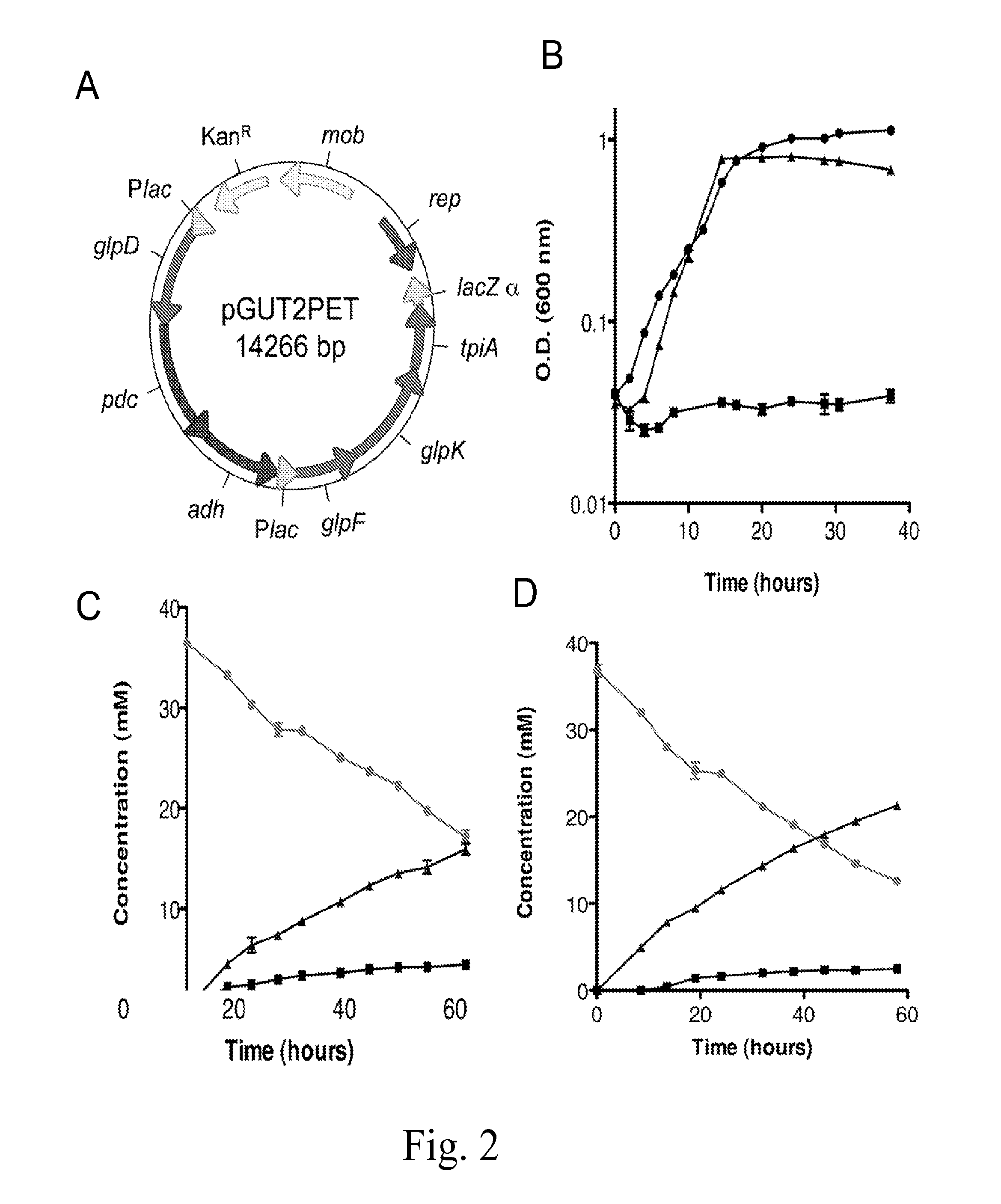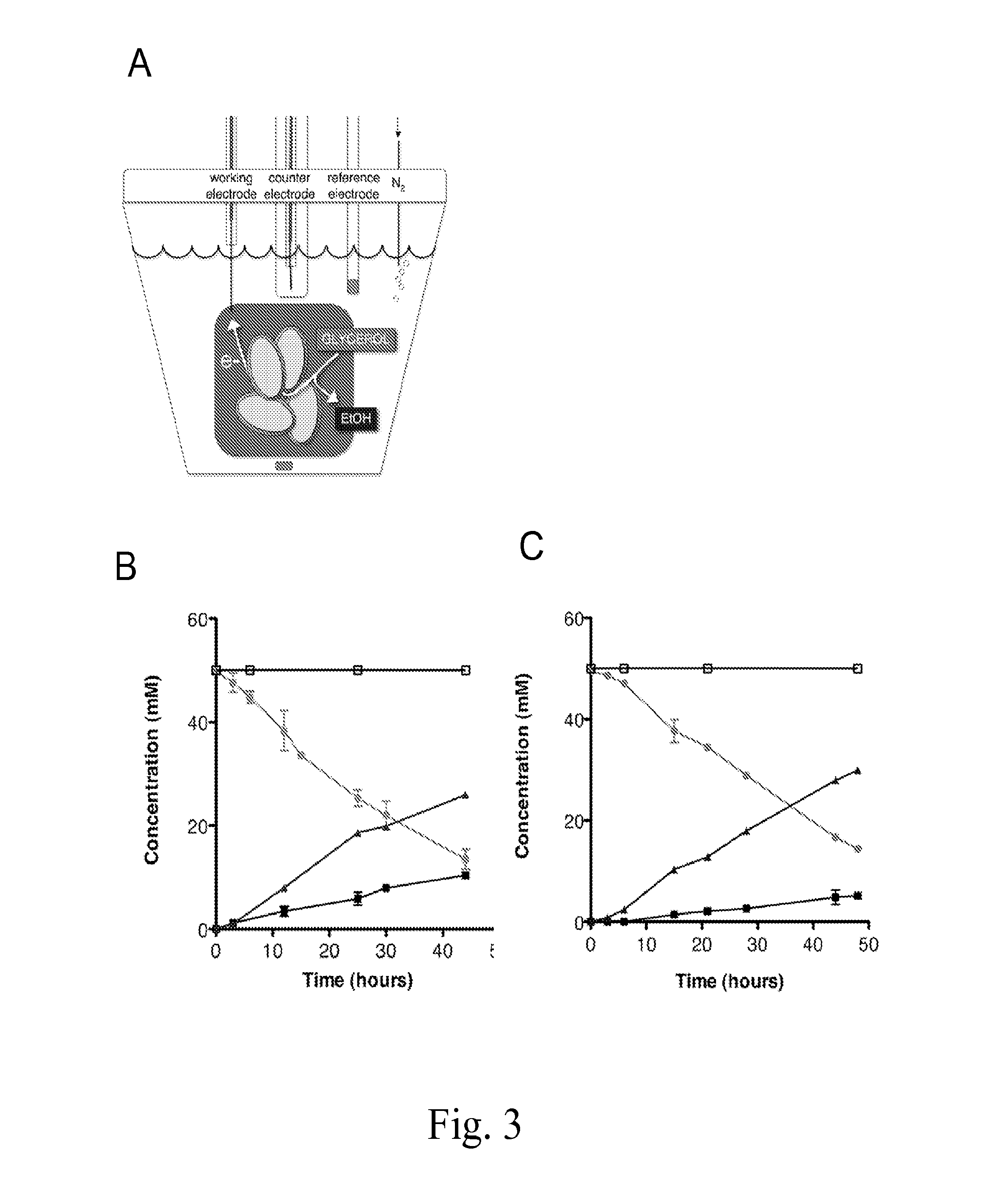Microbes, methods, and devices for redox-imbalanced metabolism
- Summary
- Abstract
- Description
- Claims
- Application Information
AI Technical Summary
Benefits of technology
Problems solved by technology
Method used
Image
Examples
example 1
[0119]
TABLE 2Bacterial strains, vectors, and primersStrainsCharacteristics and usesReference / SourceMR-1Isolated from Lake Oneida, NYA, BJG612Δpta deletion derivative of MR-1CK12Lab StockUQ950E. coli DH5a for cloningDWM3064DAP auxotroph donor strain for conjugationDVectorspBBR1MCS-25.0 kB broad-host-range-vector for cloning; KmrEpPETpBBR1MCS-2 containing pdc and adh (cloned from This studyZymomonas moblis, pLOI297)pGUT2pBBR1MCS-2 containing glpD, glpF, glpK, tpiA This study(cloned from E. coli K12)pGUT2PETpBBR1MCS-2 containing glpD, glpF, glpK, tpiA This study(cloned from E. coli K12), pdc and adh (cloned from Z. moblis, pLOI297)PrimersglpDJ1 KpnIGGGGTACCACGAAAGTGAATGAGGGCAGCASEQ ID NO: 1J2 XhoICCGCTCGAGCAGGCCAGATTGAAATCTGASEQ ID NO: 2glpFKJ3 XbaIGCTCTAGAAGCATGCCTACAAGCATCGTGSEQ ID NO: 3J4 NotIATAAGAATCGGGCCGCTGCGGCATAAACGCTTCATTCGSEQ ID NO: 4tpiAJ5 SacINNGAGCTCCGCTTATAAGCGTGGAGASEQ ID NO: 5J6 SacINNGAGCTCGAAAGTAAGTGCCGGATATGSEQ ID NO: 6glpABCJ7 HindIIICCCAAGCTTGCGCGAAATCAAACAATTCASE...
example 2
Reagents
[0127]Restriction enzymes, phosphatase, DNA polymerase mix, and T4 DNA Ligase were obtained from New England Biolabs (Ipswich, Mass.). TOPO TA cloning kit was obtained from Invitrogen (Carlsbad, Calif.). For PCR cleanup, gel extraction and plasmid preparation, QIAquick PCR Purification Kit, QIAquick Gel Extraction Kit and QIAprep Spin Miniprep Kit from Qiagen (Valencia, Calif.) were used respectively. Sodium fumarate, sodium lactate, and riboflavin were obtained from Sigma (St. Louis, Mo.).
Bacterial Strains, Plasmids and Growth Conditions.
[0128]S. oneidensis was previously isolated from Lake Oneida in New York [1B]. Overnight cultures were inoculated using a single colony from freshly streaked plates in Luria-Bertani (LB) broth. Where noted, Shewanella Basal Medium (SBM) was composed as previously described (Hau et al., 2008 Appl Environ Microbiol 74:6880-6886). Table 4 shows the strains and plasmids used in this study.
TABLE 4Strains and plasmids used.Strain or PlasmidCharac...
example 3
Bacterial Strains and Plasmids
[0133]
TABLE 5Mutant Shewanella and E. coli strains used in this study.StrainsCharacteristics and usesReference / SourceMR-1Isolated from Lake Oneida, NYA, BJG1854MR-1 ΔomcA / ΔmtrC / ΔmtrA / ΔmtrB / This workΔmtrF / ΔmtrE / ΔmtrD / ΔdmsE / ΔSO4360 / ΔcctA / ΔcymAJG1894JG 1854 with pmtrCABcymAThis workJG1825MR-1 with pmtrCABcymAThis workJG146BL21(DE3)Lab StockJG1852JG146 with pmtrCABcymAThis workJG1853JG146 with pEC86This workJG2007JG472 with pmtrCABcymA pEC86This workUQ950E. coli DH5a for cloningCWM3064Donor strain for conjugation, CDAP auxotrophVectorspSMV3Deletion vector, Kmr, sacBCpBBR1MCS-25.0 kB broad-host-range-Dvector for cloning, KmrpmtrCABcymAmtrC and 35 by upstream, mtrA This workand 38 by upstream, mtrB and 43by upstream and cymA and x by upstream in pBBR-BioBrickpBBR-BioBrickpBBRMCS-2 derivativeComplementationPrimers5′→ 3′MtrCNNNAGATCTGTTGGCGCTAGATCATASEQ ID NO: 20NNNNNNNNNNGCGGCCGCTAATAGGSEQ ID NO: 21MtrANNAGATCTTTTCTTGAATTTTGTTGGSEQ ID NO: 22NNNNNNNNNNGCGGCCGC...
PUM
 Login to View More
Login to View More Abstract
Description
Claims
Application Information
 Login to View More
Login to View More - R&D
- Intellectual Property
- Life Sciences
- Materials
- Tech Scout
- Unparalleled Data Quality
- Higher Quality Content
- 60% Fewer Hallucinations
Browse by: Latest US Patents, China's latest patents, Technical Efficacy Thesaurus, Application Domain, Technology Topic, Popular Technical Reports.
© 2025 PatSnap. All rights reserved.Legal|Privacy policy|Modern Slavery Act Transparency Statement|Sitemap|About US| Contact US: help@patsnap.com



